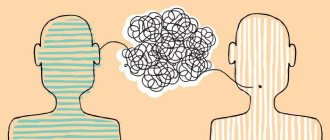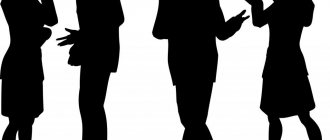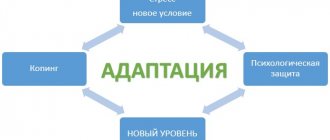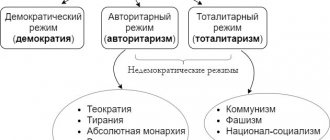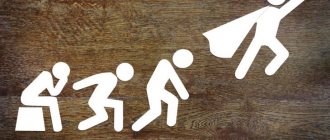Under the influence of the feelings experienced by a person, coordinated contractions and relaxations of various facial structures are born. They determine facial expressions that perfectly reflect the emotions being experienced. Since it is not difficult to learn to control the state of the facial muscles, they often try to mask or even imitate the display of emotions on the face. Knowing facial expressions during various emotions is useful not only for understanding others, but also for carefully practicing your working imitations.
The sincerity of human emotions is usually indicated by symmetry in the display of feelings on the face, while the stronger the falsehood, the more the facial expressions of its right and left halves differ.
Even easily recognizable facial expressions are sometimes very short-lived (fractions of a second) and often go unnoticed; To be able to intercept it, you need a lot of practice or special training. At the same time, positive emotions (joy, pleasure) are recognized more easily than negative ones (sadness, shame, disgust). A person’s lips are particularly emotional, and they are not difficult to read: for example, increased facial expressions or biting of lips, for example, indicate anxiety, and a mouth twisted to one side indicates skepticism or ridicule.
A smile on the face usually shows friendliness or a need for approval. A smile for a man is a good opportunity to show that he is in control of himself in any situation. A woman's smile is much more truthful and more often corresponds to her actual mood. Since smiles often display different motives, it is advisable not to rely too much on their standard interpretation:
- excessive smiling - need for approval;
- a crooked smile is a sign of controlled nervousness;
- a smile with raised eyebrows - readiness to obey;
- smiling with lowered eyebrows - showing superiority;
- a smile without lifting the lower eyelids is insincerity;
- a smile with constant widening of the eyes without closing them is a threat.
Typical facial expressions that communicate emotions are:
- joy: the lips are curved and their corners are pulled back, small wrinkles have formed around the eyes;
- interest: eyebrows slightly raised or lowered, while eyelids slightly widened or narrowed;
- happiness: the outer corners of the lips are raised and usually pulled back, the eyes are calm;
- surprise: raised eyebrows form wrinkles on the forehead, the eyes are widened, and the slightly open mouth has a rounded shape;
- disgust: eyebrows are lowered, the nose is wrinkled, the lower lip is protruded or raised and closed with the upper lip, the eyes seem to be squinting; the person seems to be choking or spitting;
- contempt: the eyebrow is raised, the face is elongated, the head is raised as if a person is looking down at someone; he seems to distance himself from the interlocutor;
- fear: the eyebrows are slightly raised, but have a straight shape, their inner corners are shifted and horizontal wrinkles run across the forehead, the eyes are widened, with the lower eyelid tense and the upper one slightly raised, the mouth can be open, and its corners are pulled back, stretching and straightening the lips above the teeth (the latter just speaks of the intensity of the emotion...); when only the mentioned position of the eyebrows is present, then this is controlled fear;
- anger: the muscles of the forehead are shifted inward and downward, creating a threatening or frowning expression in the eyes, the nostrils are widened and the wings of the nose are raised, the lips are either tightly compressed or pulled back, taking a rectangular shape and exposing clenched teeth, the face often turns red;
- shame: the head is lowered, the face is turned away, the gaze is averted, the eyes are directed downwards or “run” from side to side, the eyelids are covered and sometimes closed; the face is quite flushed, the pulse is rapid, breathing is intermittent;
- grief: eyebrows are drawn together, eyes are dull, and the outer corners of the lips are sometimes slightly lowered.
Knowing facial expressions during various emotions is useful not only for understanding others, but also for carefully practicing (usually in front of a mirror) your working imitations.
Look and eyes
His eyes openly speak about a person’s inner experiences - it’s not for nothing that experienced “players” try to hide their expression behind the glasses of dark glasses.
People are usually extradited:
- any changes in the usual expression of the eyes - the emergence of a certain emotion, a signal of response to a stimulus;
- involuntary eye movements, noticeably “shifty eyes” - anxiety, shame, deception, fear, neurasthenia;
- a brilliant look - fever, excitement;
- glassy look - extreme weakness;
- enlarged pupils - a feeling of interest and pleasure from information, communication, photography, a partner, food, music and other external factors, acceptance of something, but also severe suffering;
- constriction of the pupils - a surge of irritation, anger, hatred, initial negative emotions, rejection of something;
- chaotic movements of the pupils are a sign of intoxication (the more such movements, the drunker the person);
- increased blinking - excitement, deception.
People always prefer to look at those they clearly admire, or those with whom they have close relationships, from a close distance;
Women show more visual interest than men. During communication, they most often look into the partner’s eyes when they listen, and not when they speak, although, when carrying out suggestion, they sometimes use direct gaze into the eyes at the moment of speaking the dialogue.
A person who looks you in the eye for noticeably less than one third of the entire communication period is either dishonest or trying to hide something; the one who openly persistently peers into your eyes, experiences increased interest in you (pupils are dilated), shows outright hostility (pupils are constricted) or strives to dominate.
Modifications of eye contacts have the following meaning:
- absent look - concentrated thinking;
- shifting your gaze to surrounding objects and to the ceiling - loss of interest in the conversation, an excessively long monologue of the partner;
- persistent and intent gaze into the eyes (pupils constricted) is a sign of hostility and a clear desire to dominate;
- persistent and intent gaze into the eyes (pupils dilated) is a sign of sexual interest;
- looking away and lowering your gaze - shame, deception;
- side view - distrust;
- the gaze then looks away, then comes back - lack of agreement, distrust.
The role of nonverbal communication
Words are good for conveying logical information. At the same time, feelings are better conveyed not verbally.
Researchers estimate that 93% of the information conveyed in emotional communication comes through nonverbal communication channels.
Nonverbal communication is difficult to control even for professional artists. They must interact with the image, which is a complex creative process that is not always possible and requires rehearsal. Therefore, nonverbal communication is much more reliable than verbal communication. We can control some parameters of nonverbal communication. But we will never be able to control all parameters, since a person cannot have more than 5-7 factors in mind at the same time.
Nonverbal communication usually occurs spontaneously and unintentionally. It was given to us by nature as a product of thousands of years of natural selection. Therefore, nonverbal communication is very extensive and compact. By mastering the language of nonverbal communication, we acquire an effective and economical language. By winking, nodding our head, or moving our hands, we convey our feelings faster and better than words.
Pose and its details
Significant information about a person’s internal mood is provided by the static position of his body.
At the same time, a frequently repeated pose communicates stable personality traits. Since during changes in feelings people usually control their face better than their body, it is often not facial expressions at all, but posture that can tell about an individual’s true experiences.
Possible connections between body positions and a person’s mental state are as follows:
- hands clasped behind the back, head raised high, chin pointed out - a feeling of self-confidence and superiority over others;
- the body is leaned forward, hands (akimbo) on the hips - self-confidence and readiness for active action, aggressiveness, nervousness when talking, the desire to defend one’s position to the end;
- standing with your hands on a table or chair - a feeling of incomplete contact with your partner;
- hands with elbows spread behind the head - awareness of superiority over others;
- putting your thumbs in your belt or in pocket slots is a sign of aggressiveness and demonstrated self-confidence;
- sticking your thumbs out of your pockets is a sign of superiority;
- crossed limbs - skeptical defensive attitude;
- uncrossed limbs and an unbuttoned jacket - establishing trust;
- tilting the head to the side - awakening interest;
- tilting the head down - a negative attitude;
- a slight tilt of the head back is a sign of aggressiveness;
- sitting on the tip of a chair - the readiness to jump up at any moment in order to either leave, or act in the current situation, or to calm the accumulated excitement, or to attract attention and join the conversation;
- crossing your legs over your legs and crossing your arms over your chest is a sign of “disconnecting” from a conversation;
- throwing your leg over the armrest of a chair (while sitting on it) - disdain for others, loss of interest in conversation;
- crossed ankles of a person sitting - holding back a disapproving attitude, fear or anxiety, an attempt at self-control, a negative defensive state;
- position (sitting or standing) with legs oriented towards the exit - a clear desire to stop talking and leave;
- frequent changes of posture, fidgeting in a chair, fussiness - internal restlessness, tension;
- standing up is a signal that a certain decision has been made, the conversation is boring, something surprised or shocked;
- clasped fingers - disappointment and the desire to hide a negative attitude (the higher the hands are located, the stronger the negative);
- the hands are connected by the fingertips, but the palms are not touching - a sign of superiority and confidence in oneself and in one’s words;
- hands rest with their elbows on the table, and their hands are located in front of the mouth - hiding their true intentions, playing cat and mouse with a partner;
- supporting the head with the palm of your hand - boredom;
- fingers clenched into a fist are located under the cheek, but do not serve to support the head - a sign of interest;
- resting your chin with your thumb is a sign of some kind of critical assessment;
- clasping your glass with both hands is a disguised nervousness;
- blowing smoke from a cigarette upward - a positive attitude, self-confidence;
- blowing smoke from a cigarette downward - a negative attitude, with hidden or suspicious thoughts.
The importance of sensorimotor signals
The ability to correctly interpret nonverbal signals is of great importance in modern human life. After all, it is precisely such gestures that most fully express human feelings and experiences. In some cases, emotional experiences can be so strong that without verbal signals it is almost impossible to convey the whole gamut of overwhelming emotions. In addition, these gestures allow you to establish deeper communication contact between interlocutors.
Often, such knowledge allows one to achieve certain results in entrepreneurial activity. The main feature of nonverbal signals is that a person cannot control them. Examples of using such means of communication allow you to learn to detect false notes in the words of your interlocutor and avoid attempts to manipulate your behavior.
A person who knows the basics of nonverbal communication better understands the interlocutor, which allows him to distinguish lies from the truth.
Gestures and body movements
“Gesture is not a movement of the body, but a movement of the soul.” It communicates a person’s desire and what he is experiencing at that moment, and a habitual gesture for someone testifies to a trait of his character. Outwardly identical gestures from different people can mean completely different things, but there are also identical points:
- active gestures are a frequent component of positive emotions, understood by others as an expression of friendliness and interest;
- Excessive gesticulation is a sign of anxiety or insecurity.
When determining an individual’s thoughts and emotions, only involuntary gestures should be noted:
- showing open palms is an indicator of frankness;
- clenching of fists - internal excitement, aggressiveness (the stronger the fingers are clenched, the stronger the emotion itself);
- covering your mouth with your hand (or a glass in your hand) at the moment of speech - surprise, uncertainty in what is being said, a lie, a confidential message, professional insurance against lip reading;
- touching the nose or lightly scratching it - uncertainty in what is being communicated (both by oneself and by a partner), lying, searching for a new counterargument during the discussion;
- rubbing your eyelid with a finger is a lie, but sometimes - a feeling of suspicion and lies on the part of your partner;
- rubbing and scratching various parts of the head (forehead, cheeks, back of the head, ear) - concern, embarrassment, uncertainty;
- stroking the chin - the moment of decision making;
- fussiness of hands (fiddling with something, twisting and untwisting a pen, touching parts of clothing) - alertness, nervousness, embarrassment;
- pinching the palm - readiness for aggression;
- biting nails - internal anxiety;
- all sorts of hand movements across the body (adjusting a watch, touching a cufflink, playing with a button on a cuff) - masked nervousness;
- picking up lint from clothes is a gesture of disapproval;
- pulling a collar that is clearly in the way from the neck - a person suspects that others have recognized his deception, lack of air when angry;
- wiping the glasses or placing the frame of the glasses in the mouth - a pause to think, please wait;
- taking off glasses and throwing them on the table is an overly sensitive conversation, a difficult and unpleasant topic;
- extinguishing or putting aside a cigarette is a period of maximum stress;
- knocking ash off a cigarette too often - a painful internal state, nervousness;
- tilting the head to the side - awakening interest;
- a quick tilt or turn of the head to the side - a desire to speak out;
- constantly throwing away supposedly “interfering” hair from the forehead - anxiety;
- a clear desire to lean on something or lean against something - a feeling of difficulty and unpleasantness of the moment, lack of understanding of how to get out of the current situation (any support increases self-confidence).
ATTENTION!
Tomorrow, Clerk will start training in an online training course to obtain a certificate that will be included in the state register. Course topic: management accounting .
- Duration 120 hours in 1 month
- Your ID in the Rosobrnadzor register (FIS FRDO)
- We issue a Certificate of Advanced Training
- The course complies with the professional standard “Accountant”
Increase your value as a specialist in the eyes of the director. View full program
Types of nonverbal communication
Nonverbal communication is a type of communication without the use of words.
Nonverbal communication plays an important role in the exchange of information and emotions between both humans and animals, including between humans and trained animals.
Observations have shown that in communication processes from 60% to 95% of information is transmitted through non-verbal communication.
The components of nonverbal communication are:
- Voice,
- appearance, clothing, posture,
- facial expressions, smiles, glances,
- Movements,
- gait,
- gestures,
- touch, handshake, hug.
Communication without words is the most complete and authentic.
During communication, we not only listen to verbal information, but also look into the other person’s eyes, perceive the timbre of the voice, intonation, facial expressions and gestures.
Words give us logical information, and gestures, facial expressions and voice complement this information.
Nonverbal communication - communication without words often occurs unconsciously. They can either complement and strengthen verbal communication, or contradict and weaken it. Although nonverbal communication is often an unconscious process, it is now fairly well understood and can be successfully manipulated to achieve the desired effect.
Nonverbal communication is the oldest and most basic form of communication. Our ancestors communicated with each other through body tilt, facial expressions, tone and intonation of voice, breathing rate, and glances. Even today we often understand each other without words.
Nonverbal language is so powerful and common that we can often easily understand what a dog wants. A dog, on the other hand, anticipates many of our actions, knowing in advance, for example, when we will take it for a walk and when we will go out without it.
Some animals live alone, like bears. Therefore, they have undeveloped non-verbal language (eg, facial expressions, ear position, facial smiles). As a result, a seemingly good-natured bear can startle the trainer. You must be especially careful when training animals with poorly developed nonverbal language.
Nonverbal communication is not as well structured as verbal communication. But there are general rules of vocabulary and composition (grammar) of gestures, facial expressions, intonation, with the help of which we can clearly convey our feelings.
Such transfer depends on many factors and is often ambiguous. Conscious transference is a creative process that is professionally practiced by film and theater artists. At the same time, each artist conveys the same role in his own way. Repeatedly we saw the same roles by different artists, the same films shot by different directors.
Intentionally conveying feelings we do not have is a difficult, if not impossible, process. Therefore, during filming, artists try to get into the character and experience the same feelings that they are trying to convey. We often notice this kind of failure and say that the film is a failure: the actors, for example, act unnaturally, go too far. Yet we use nonverbal language to express our feelings: Love and hate, superiority and dependence, respect and contempt.
Some non-verbal language is universal: all children cry and laugh the same way. The other part, such as gestures, differs from culture to culture. Nonverbal communication is mostly spontaneous. We usually formulate our thoughts in words; the posture of our body, facial expressions and gestures occur involuntarily, divorced from consciousness.


